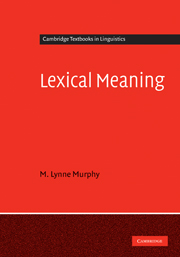Book contents
- Frontmatter
- Contents
- List of figures
- Preface: using this book
- Acknowledgments
- Typographical conventions
- Part I Meaning and the lexicon
- Part II Relations among words and senses
- Part III Word classes and semantic types
- 7 Ontological categories and word classes
- 8 Nouns and countability
- 9 Predication: verbs, events, and states
- 10 Verbs and time
- 11 Adjectives and properties
- References
- Index
7 - Ontological categories and word classes
from Part III - Word classes and semantic types
Published online by Cambridge University Press: 05 June 2012
- Frontmatter
- Contents
- List of figures
- Preface: using this book
- Acknowledgments
- Typographical conventions
- Part I Meaning and the lexicon
- Part II Relations among words and senses
- Part III Word classes and semantic types
- 7 Ontological categories and word classes
- 8 Nouns and countability
- 9 Predication: verbs, events, and states
- 10 Verbs and time
- 11 Adjectives and properties
- References
- Index
Summary
Key words:
word class, ontology, ontological category, semantic type, time-stability, derivation
Overview
We are used to hearing descriptions like “a noun names a person, place, or thing” or “a verb is an action word.” If you have already studied some linguistics, you've probably learnt that these semantic descriptions of word classes are insufficient, and instead categories like noun and verb are best defined by their morphosyntactic properties – such as where they can occur in sentences and what suffixes they can take. After all, any English noun can head the subject of an English sentence, but not all such nouns denote persons, places, or things (e.g., oblivion, unconventionality), and all lexical verbs in English sentences agree with their subjects, but not all describe actions (e.g. resemble, prefer). Nevertheless, there may be something to the notion that nouns are more thing-like and verbs are more action-y. In this chapter we introduce ontological, or semantic, categories, which can be used to classify meaning types, and look at the degree to which these semantic types correspond to grammatical word classes. This includes looking at the question of what happens when we use different word classes to describe the same kind of thing. For example, does it mean something different to use an adjective rather than a noun, as in Richard is optimistic and Richard is an optimist?
- Type
- Chapter
- Information
- Lexical Meaning , pp. 135 - 147Publisher: Cambridge University PressPrint publication year: 2010

